

 DECO2200
DECO2200






 DECO2200
DECO2200






In response to the design brief, the problem area chosen was 'Health & Wellbeing', with the focus on mental health as the problem scenario.
The conversation around mental health has been more prevalent in recent years because of the pandemic. Having had personal experiences struggling with mental wellness before and during that time, our group has decided to choose this topic as our primary focus.
We have chosen to go on trajectories that had greatest impact on us, but our research circled back to aspects of urban lifestyles that affected our psychological and emotional states.
mental health - includes our emotional, psychological, and social well being: affects how we think, feel, and act, and determines how we handle stress, relate to others, and make healthy choices
mental wellbeing - the combination of feeling good and functioning well; the experience of positive emotions such as happiness and contentment as well as the development of one’s potential, having some control over one’s life, having a sense of purpose, and experiencing positive relationships
problem area


What do we know about urbanisation and its effects on mental health?
Cities are associated with higher rates of most mental health problems compared to rural areas: an almost 40% higher risk of depression, over 20% more anxiety, and double the risk of schizophrenia, in addition to more loneliness, isolation and stress (UDMH, 2016; Gruebner et. al, 2017).
The reasons can be attributed to a range of reasons, from preexisting risk factors from a change of environment, social factors such as lack of social cohesion and prejudice, and environmental factors (UDMH, 2022) such as overload (Milgram, 1970).
In the past ten years, research has shown that there are biological factors that contribute to the increased risk of mental struggles when growing up in the city. More predominantly, there is an increased size of amygdala and pregenual anterior cingulate cortex (pACC) which help identify threats and regulate stress respectively (Haddad et. al, 2014; Benedictus, 2014).
Yet the relationship between the two parts of the brain is weaker, which implied that individuals who grew up in the cities have a weaker ability to process and control emotions.

problem area

Cities cause an increase in stimulus levels because of their: Density Crowding - Smells Sights Disarray Pollution Noises - Other inputs
Coined by Stanley Milgram in the 70s in his writing 'Experience of Living in Cities', overload is caused by cumulative effect of environmental stressors that tend to be prevalent in the cities.
It leads to a heightened base level of arousal, stress and preparedness.

Sense



Depression or general unhappiness
Physical
- Severe headaches Feeling tired

In the United States, noise control and noise research has not been vigorously funded since the 1980s (UDM 2016).
Yet there is overwhelming evidence to show that exposure to environmental noise has adverse effects the health of the population. Traffic noise is even ranked second among environmental threats to publ health the first being air pollution (Carruthers, 2017).
Using science and technology, while we have found ways to measure and mitigate air pollution, there is st a lack of data on noise pollution, its impact on our physical and mental health, and the possible solution to alleviate its effects.
These have driven the objective of the research.



Investigate the extent to which urban noise has an impact on mental wellness
Investigate whether sounds can offer a restorative effect to the state of mind
With 68% of the world's popu 2050 (United Nations, 2018), will help maintain wellbeing o
Why is it important to understand the relationship we have with sounds?
problem area
Because of the nature of this topic, qualitative data was the most appropriate and feasible to gather the thoughts and emotions of individuals living in an urban environment.



Despite this, the importance of triangulation (Nielsen Norman Group, 2021) still applies, where diversifying user research methods ensures more reliable and valid results.
Research triangulation was used to gather primary data, on top of secondary research on current literature.

(see Appendix 1)
Semi structured interviews were conducted to understand how sensory input affects their mental state. Even though this research focused on sounds, there was also value in understanding if sounds were coupled with visual stimulus and/or contextual experience to restore peace in individuals.
Interviews were also effective in gathering data on the urban sounds that cause the most annoyance in participants because many tend to remember sounds that affect them most. Ideally, the final solution could help counter some of these sounds.
Six youths age 20-25 were interviewed. These Gen Z individuals were the first to grow up with the smartphones, and spends four hours a day with audible content, streaming videos, podcasts and listening to music. They are also capable of making shifts in consumer trends (as seen from the rising trend of retro wired headphones), and hence are powerful in the technology market.
Two adults in their mid-50s were also interviewed. They were individuals that contrasted the others. The purpose was to discover if the idea of "peace" and "noise" were universal across age groups, and whether growing up in a different era would have an impact on their reactions to sounds. It was during their teenage years when sound research and products became popular.
(see Appendix 2)

After gathering interview data from eight interviewees, the process of affinity diagramming was used to organise ideas and points into clusters. These clusters are then phrased into key insights, which help to focus the direction for ideation later.
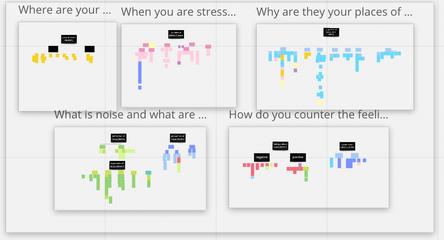
There are five main clusters of ideas which were recognised from interview questions and answers:
1.

Where are your places of peace?
When you are stressed/anxious, what do you do to feel at peace?
Why are they your places of peace?
What is noise and what are your examples?
How do you counter the feelings that noise make you feel?
Consistent with Milgram's theory on 'Overload", participants tend to seek peace in quiet areas (search for physical and emotional privacy) with little human activity (withdrawal from social, moral and environmental interactions).
Most individuals are more likely to head out of the house, to physical places based on popularity such as: 1. the park and the beach; 2. shopping mall and library. There are few that will choose staying at home and in their bedroom, but they will also make use of other interventions to distract themselves from their stress and anxiety. This includes using social media, watching videos and sleeping.

Often, it is the context and symbolism of these places, coupled with people's sensory experiences that make them enjoy a space and for these places to bring them peace.
For example, the beach tended to be associated with feelings of relaxation, and the park, alongside family activities and children's play, is associated with excitement and joy.
Besides peace places themselves (external), most people also found peace in places and activities where they have control over (internal). This is used to counter the sense of stress and anxiety that they may have from situations that lack thereof.
The most common and intuitive physical property related to peace places was quietness coupled with nature sounds, mostly water. Other nature sounds include birds chirping and the sounds of leaves.
From the interviews, it seems that quietness refers to the lack of sounds generated from human activity rather than total silence, which creates a feeling of vastness that is associated with peace.

In fact, the lack of sound (silence) felt uncomfortable and lonely to many, and they would prefer heading out to engage with the world to feel at peace.
Other physical properties include visuals (no people in sight and orderliness), cooling, and smells of peace places (not specific).

physical park beach gym & exercise place shopping mall
non-physical home bedroom
hiking sports gettingadrink listeningtoocean listeningtoconversations watchingpeople
pacinginroom uselaptop watchingvideos socialmedia talktofriends
"beinginaspacewherethereishappy emotionsbecauseoftheactivitiespresent likefamilieshavingpicnics,dogsrunning around,childrenplaying"
"listeningto conversationsmakeme realisethatmyproblems aren'tthatbig"
"Ijustwanttorelief someofmybad emotions,andhave someonethere."
"Igotowhereitisfamiliarandnear "
"theoceangivesmestrengthbecause ofhowpowerfulitis,andhowmuchit hassurvivedthroughtime "
"IthinkIusetheseas distractions nopoint doingworkwhenI'm stressed."
being able to move around and get fresh air makes people feel like they are not stationery and hence are productive in their progress in solving current problems
depending on context, the environment also helps reframes problems and shifts mindsets to deal with stress
even though they are distractions, they help put a temporary pause on people's stressors. they allow time away.
they help to reset emotions and thoughts by avoidance, but should not be used as a long term method for dealing with stress.
headphones doingwhatIenjoy listeningtomusic:
>jazz >ambientmusic >meditativemusic
"IlikethatI'mincontrol ofmyownspace "
"Iammostatpeace whenIdothethingsI liketodo"
"Idon'tneedtoentertain anyone noexpectations"
hiking watchingtheworldgoby chill getcoffeeandlistento peopletalk
"thereispeacebeing abletosavourtheworld aroundyou "
"watchtheworldgoby" "justseetheworld revolveandmove "
"lookatinteractions,nothingtoo specific-wastehalfanhourjustto dosomethingrelaxing"
being in control of the space and activities in a comfortable space encourages the slowing down of life, often when the external world (i.e. urban life) has a fast-paced lifestyle.
this breeds self awareness and consciousness with mind-body connection.
engagement with the physical world, more specifically, a space that reminds one of their presence is key to reaching peace.
this grounding practice nurtures the relationship between self and the world a mind-body-world connection.

Noise is understood as sounds that appear and exist out of one's control, and that are sounds that are perceived through different lenses based on the context that the individual is in. The most common examples of noise, in levels of popularity: 1. people voices (talking, chattering, murmuring, arguing, quarrelling, yelling), 2. construction sounds (mechanical noise, drilling, hammering, banging), 3. vehicle and transport sounds (cars, ambulances, motorcycles, traffic), 4. alarms and 5. other specific sounds.
The physical properties of sounds that make them noise are: loud, disruptive, unexpected, consistent and repetitive. There are also contextual properties of sounds that make them noise: 1. sounds that are a mix of other sounds (signalling that many things are happening simultaneously) and 2. sounds that are boisterous and obnoxious.



Noise can therefore be "negative" or "positive" (point 8).
Because noise is contextual (point 5), the feelings evoked can be both negative and positive. Negative emotions include anger, frustration, agitation, shock and discomfort; while positive emotions include a sense of productivity, engagement with the external world, progress, liveliness and activity.
The most common way to counter the negative feelings evoked by noise include 1. moving away from the situation, 2. making use of headphones (listen to music background music vs upbeat songs), 3. playing videos (voice narration) and 4. calling a person.
people voices mechanicalnoise, drilling,
talking, chattering, murmuring, arguing,
noise definedas:outofone'scontrol; basedoncontext; canbepositiveornegative







construction cars, vehicle & transport
physical properties
loud; disruptive; unexpected; consistent; repetitive
contextual properties
mix of things happening simultaneously; insensitive; obnoxious; boisterous
negative




discomfort; anger; frustration; agitation; shock
sense of productivity; engagement with external world; progress; liveliness & activity; peaceful
moving away; making use headphones; videos; calling a person
alarms clocks, platesclattering, steamingofmilk, occasionaldogsbarking, doorsshutting other specific26 youths aged 21 25 responded to a questionnaire sent out to understand several key points that contribute to the project's research objectives. Questionnaires are useful in gathering large number of responses, and therefore help validate or eliminate past assumptions.
The key points of this questionnaire are:
1. 2. 3.

How much of their environment - work, rest and commute, and therefore their mental state is impacted by urban noise?
How much are sound interventions actively used to counter these urban noise?
What sounds best restore peace?
questions
The questions in the questionnaire are as follows:
1. 2. 3. 4. 5. 6. 7. 8. 9. 10.
How quiet do you think your living neighbourhood is?
How quiet do you think your workplace is?
Out of 24 hours in a typical day, how much time do you listen to selected sounds in TOTAL?

How often do you choose to listen to your own selected sounds rather than the environmental sounds at the place you are in?
How often do you choose to listen to your own selected sounds rather than the environmental sounds at the place you are in, while commuting in a city?
How often do you choose to listen to your own selected sounds rather than the environmental sounds at the place you are in, while in nature?
How often do you choose to listen to your own selected sounds to restore your state of peace in a stressful situation?
To what extent does music impact your mental wellbeing?
To what extent does environmental sounds in the place you are in impact your mental wellbeing?
What sounds make you feel at peace? Rank them from 1 to 6.
(see Appendix 3)
At places of living (rest) and places of work, 56.8% and 80.7% of respondents have pointed out that these places have at least moderate to high levels of urban noise respectively.
In general, 19 out of 26 respondents said that they would more likely choose to listen to their own selected sounds rather than the environmental sounds in the context that they are in.
This number peaked to 21 respondents when they are commuting in the city. In contrast, only 4 respondents will do so when they're travelling in nature.
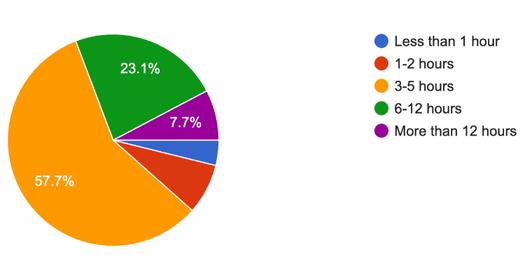

Out of 24 hours in a typical day, 15 out of 26 respondents spend at least 3-5 hours a day listening to their sounds of choice for example, music, podcasts, videos, TikToks etcetera.
In a stressful situation, 22 out of 26 respondents have mentioned that they would make use of selected sounds, such as music, white noise and nature sounds, to restore their state of peace.
While 16 of them believe that environmental sounds (silence, traffic, birds) have impact on their mental wellbeing, an increased 21 out of 26 respondents believes that music has an above-average impact.
In fact, the sounds that make people feel at peace when asked to rank, are in levels of popularity: 1. (tied) music and water sounds; 2. (tied) forest sounds and water sounds; 3. music; 4. white noise; 5. silence.
(see Appendix 4)

The use of contextual observations was useful in helping to study people's behaviours in different environments, such as workplaces, homes and public spaces without intervention. This means that we are able to understand how people interact with the product, service or space most instinctively, and therefore offer changes to any point of the interaction to improve the experience.
Observations were made in several public areas, but mostly in places which were centres of commute and transport train stations, bus stops and even on the street.
The times of the day for observations also differed ranging from a typical workday morning, a weekend afternoon, a workday evening and a weekend evening. The purpose is to investigate whether there is a difference in behaviour during peak and non peak hours, and a stressful and a more relaxed day.
workday morning (9am)
weekend afternoon (2pm)
workday evening (5pm)
weekend evening (5pm)
Across all time frames, a vast majority (estimate more than 50%) of individuals will be using their headphones.
Most of the individuals with headphones are estimated to be of ages 15 and above. There were only two to three elderly individuals observed using headphones during that time frame.
Except for groups of people who were communing together to work, to school or other places, most people had headphones on, either listening to music and/or podcasts, scrolling social media, on a call with someone, playing video games or watching drama.
It was during peak hours (weekday morning and workday evening) when most people had their headphones in, and this was less so for the quieter afternoons. Weekend evenings tended to be bustling with friends and gatherings, and therefore had significantly less number of people engaged in their digital devices.
An interesting observation was that there were more people seen putting on their headphones while on public transport vehicles. Most people who were already walking had headphones on. This observation meant that plugging in of headphones is seen more as a stationery activity (i.e. when on the public transport, or before leaving the previous venue), as an anticipation for a future activity and a set up for a state of mind.
From a stressful to peaceful state, there is a use of distraction methods and mindfulness practice. Both involve a form of sound intervention, mostly either by the sound of water or listening to music.
While noise is agreed by many as "disruptive", the complete absence of it silence makes individuals feel uneasy, lonely and even unprogressive.

Hence, a mix of low frequency and low volume sounds is key to nurturing a peaceful context.
The pleasantness of sounds - hence determining whether it is "noise" and/or affecting mental wellbeing is largely contextual and dependent on whether it is within one's control. This is perhaps why music has a mental impact on many, because of its power to change contexts and manipulate emotions.
The majority of respondents experience moderate to high levels of urban noise in their day to day lives.
Most people admit that they have gotten used to these urban sounds, yet they still choose to spend a bulk of their time while travelling, at places of rest and places of work listening to their sounds of choice.
Why is this so?
In fact, through observations over different times of the day, the use of headphones is a prevalent intervention across youths, but less so for the elderly. This can be attributed to the younger generation being digital natives.
Besides altering emotions (pathos), sounds have the power to encourage a grounding practice that nurtures a mind body world connection. This is helpful in making individuals feel at peace, and/or reframe their thoughts and mindsets (logos).
The most common activities include listening to music, watching social media content, watching shows, playing games and being on calls.
Among the key highlights, one of the main questions that required further reading was:
if headphones were not used as a way to negate urban noise because people have "gotten used to it", why are so many people still making use of headphones at places of rest, while commuting and at work?
lack of mindfulness
why?
why?
why?
starthere

(Cristol, 2019; Waters, 2021)
Dopamine is often known as the "feel good" chemical being released in the brain. Scientifically, it is a neurotransmitter that activates the nervous system to send signals for pleasure sensations. For example, when we have good food or go exercise.
The digital age and social media have provided us with instant gratification when we enjoy something on TikTok, or get social appraisal through social media. Listening to music has also shown to increase levels of dopamine.
why?
they are bored, or do not want to sit with their own thoughts
they want to be entertained without judgment
When we engage in these activities, they reinforce the association between stimulus (e.g. the like on social media) or sequence of behaviours (e.g. listening to a specific playlist) and feel good reward that follows.
The way dopamine works is that, it increases when we have an anticipation of doing something, as well as when we do the thing itself.
Therefore, this anticipation makes us constantly engage in these activities, leading us to dopamine addiction.

they want to create a dissociated environment that is just for themselves
they want to listen to their own sounds
why? people use headphones while in public spaces
Hence, this desire for dopamine keeps us away from reflecting on our own thoughts, which to many, may be an intimidating and stressful task. It is a distraction, and an avoidance.

Using insights from before, reframing techniques are used to help reconstruct the problem. These lenses help to focus the possible directions for future solutions to minimise urban noise. They pinpoint areas of focus and therefore can be strategic in nature.
Triangulation was also adopted with the intent to ideate from differing users, experiences and perspectives.

Might We'

'How Might We' Statements (HMWs) (Nielsen Norman Group, 2022) are the important in betweens of problem identification and ideation. They ensure that a team is focused on solving the right problems, and to ideating from the big picture perspective rather than suggesting their own pet solutions.
The assessment of good HMWs are based on five criteria:
1. 2. 3. 4. 5.

Is it based on an existing insight?
Does it address the root problem for a desired outcome and not the symptom of the problem?
Is it broad enough for creative ideas?
Does it suggest a solution? (Avoid)
Is it written positively?
Based on the key highlights identified in the primary research, the following HMWs were generated:
How might we empower users with data on the sounds of cities that impact their mental health?
How might we give more control over sounds to individuals to improve on their day-to-day interactions by building on current interventions?
How might we offer more opportunities for grounding as a mindful practice using technology, so as to improve mental wellness in urbanised settings?
How might we restore dopamine balance in the long-term, using the same technology that causes its imbalance?


Personas are a representation of user characteristics, needs, desires, motivations and frustrations. They are created from insights, and hence are representatives of a wider target audience, rather than a single individual.

age: 25
home location: small apartment in surry hills work location: martin's place mode of transport: train and walk family: 2 parents and 2 siblings technology expertise: 7/10
1. Wants to create a sense of safety for herself in the comforts of her own home
2. Often in need of moments of solitude because of hustling working conditions and crowded living conditions
3. Often in need of relief from stressors from work and self expectations
Michelle is a city dweller, who also grew up in the city. She lives together with her family, and has a full time job working as an investment banker. She has a high paced lifestyle and is constantly exposed to stressors, both at work and at home.
Michelle is a well travelled and educated individual, and values her own personal time She understands the importance of mindfulness and hopes to practise it in her daily life.
1 Finds it difficult to find time and space for herself given her lifestyle and shared personal space
2. Sensitive to sounds, hence requires very specific settings to concentrate or to relax


3 Home is always exposed to urban noise
4. Finds it difficult to focus on a single person while meeting clients (or in big groups) in a noisy setting distracting
1. Wants to instil a sense of liveliness when home alone
age: 19

home location: house in penrith school location: redfern mode of transport: train and walk family: 2 parents technology expertise: 8/10
2. Wants to be able to recreate the experience of him at the beach
3 Often in need of relief from stressors from school work
4. Often in need of connection with friends living further away

Lucas lives in the inner west together with his parents, who also work full-time, often late into the night He often heads straight home after school because of his long trip back home.
Lucas is often left to his own devices literally and metaphorically. He feels disconnected when he is unable to spend time with his friends at school, and comes home to a big empty house because of his parents work
Coupled with the stress from school, Lucas feels a built up of anxiety, isolation and loneliness. He feels most connected to the ocean.
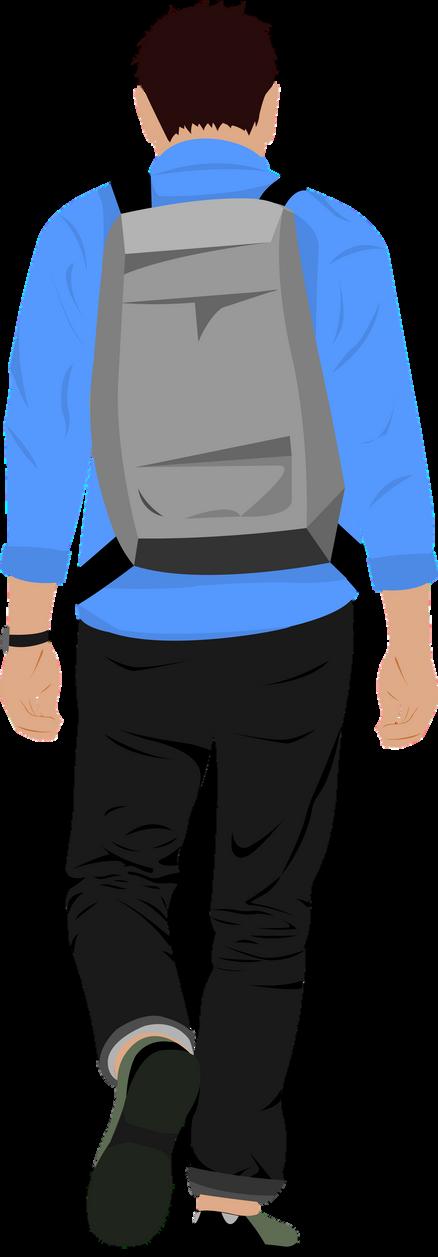
1. Finds it difficult to disconnect with social media because it makes him feel as though he's involved but actually lonely
2. Finds silence in his neighbourhood and his house isolating, and wants ways to be able to feel like he is connected to the busier world
3. Finds it difficult to relief his anxiety about school, his friendship status and his distance from his parents, especially living far from a water source


age: 22
home location: house in maroubra work location: everywhere mode of transport: cycle and walk family: 1 parent and 1 sister technology expertise: 7/10
1. Wants to be able to travel around safely without being a danger hazard to others
2. Wants to discover music and share it with his friends while on-the-go
3 Wants to be given directions on his job and/or while he is exercising and/or on general travels
Max has an active lifestyle he loves being outdoors, running, cycling and going to the gym. He lives in a house with his mother and younger sister.
Besides going to university, Max has a casual job as a UberEats delivery cyclist to earn some extra pocket money. He understands the pressure on his mother to support two children independently.
When he is active, he likes putting in his earpieces to travel around He is also dependent on music to regulate his moods
1. Finds it difficult to multitask look at his phone for directions, receive notifications for the next order, change the music he is listening to, look out for oncoming traffic etc (simultaneous stimuli)
2. Curious about why he prefers a certain type of music compared to another but doesn't know where to start to try to understand his brain
3 Often has to be on call with his sister when she is at home alone to be present with her
age: 26
home location: apartment in balmain work location: balmain mode of transport: walk and bus family: lives by herself technology expertise: 6/10
1. Wants to create a community to practise mindfulness regularly
2 Sustaining her yoga studio business
3. Recreate the calming energy in the studio in her own space at home
4. Wants to be further pushed to practise mindfulness while on-the-go

Lina is a spiritual individual. She practises yoga and meditation regularly, and owns her own yoga studio. She believes in practising mindfulness, and hopes to encourage more of her peers to do so.
Living alone, she has a lot of mental and physical space for herself, but occasionally, she feels lonely in her space.
Because of the pandemic, she has learnt how to stream classes online to sustain her business and share her passion. However, she admits she is not technologically savvy, and hopes to minimise any digital intervention in the future.
1 Despite the digital revolution, she hopes to minimise the need for any digital intervention in her studio (based on yoga philosophy) but she is open to change her mind if a technology suits her philosophy
2. Finds it difficult to target a bigger market of yogis for her studio realises that she's been limited to those in her geographical vicinity


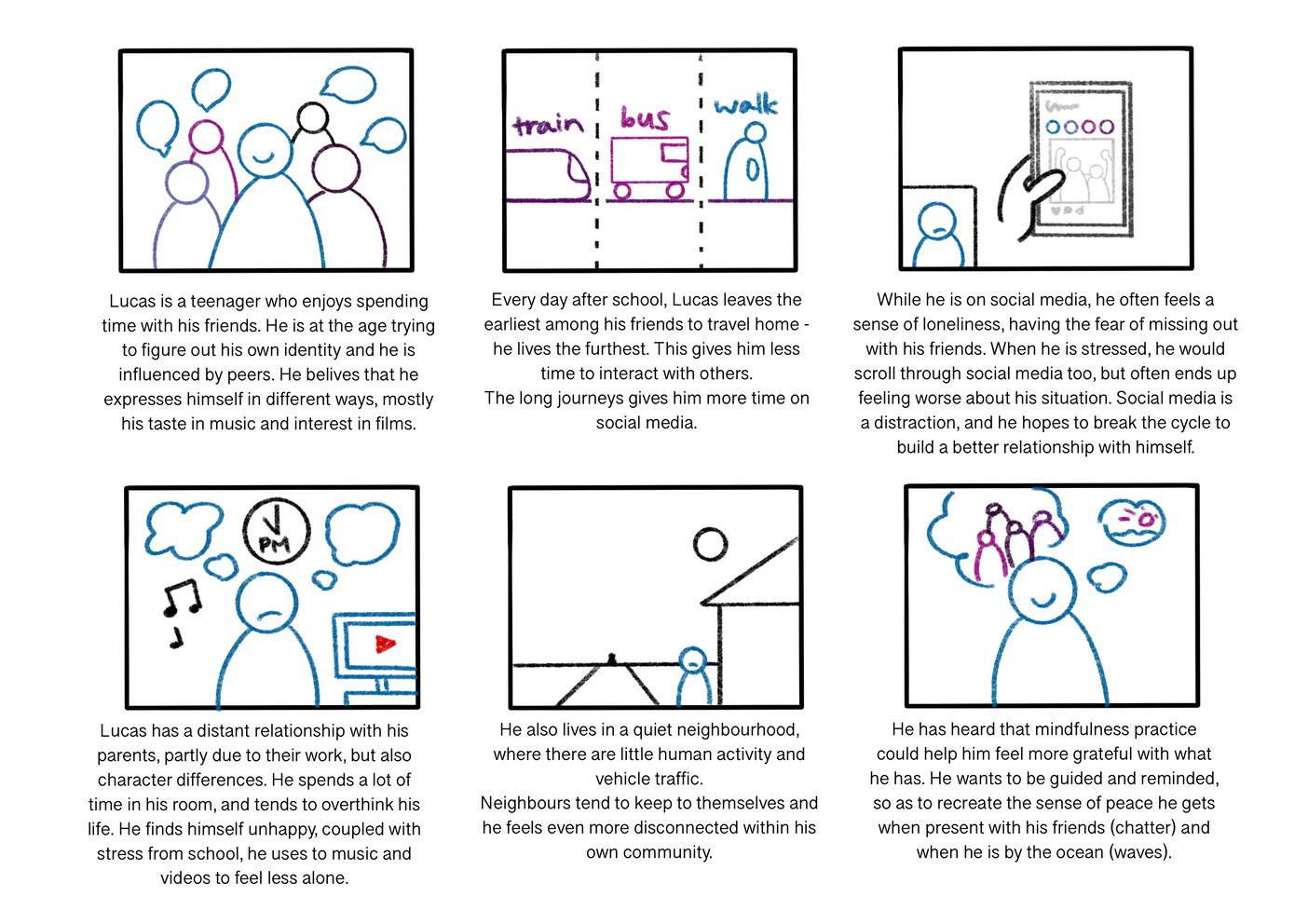


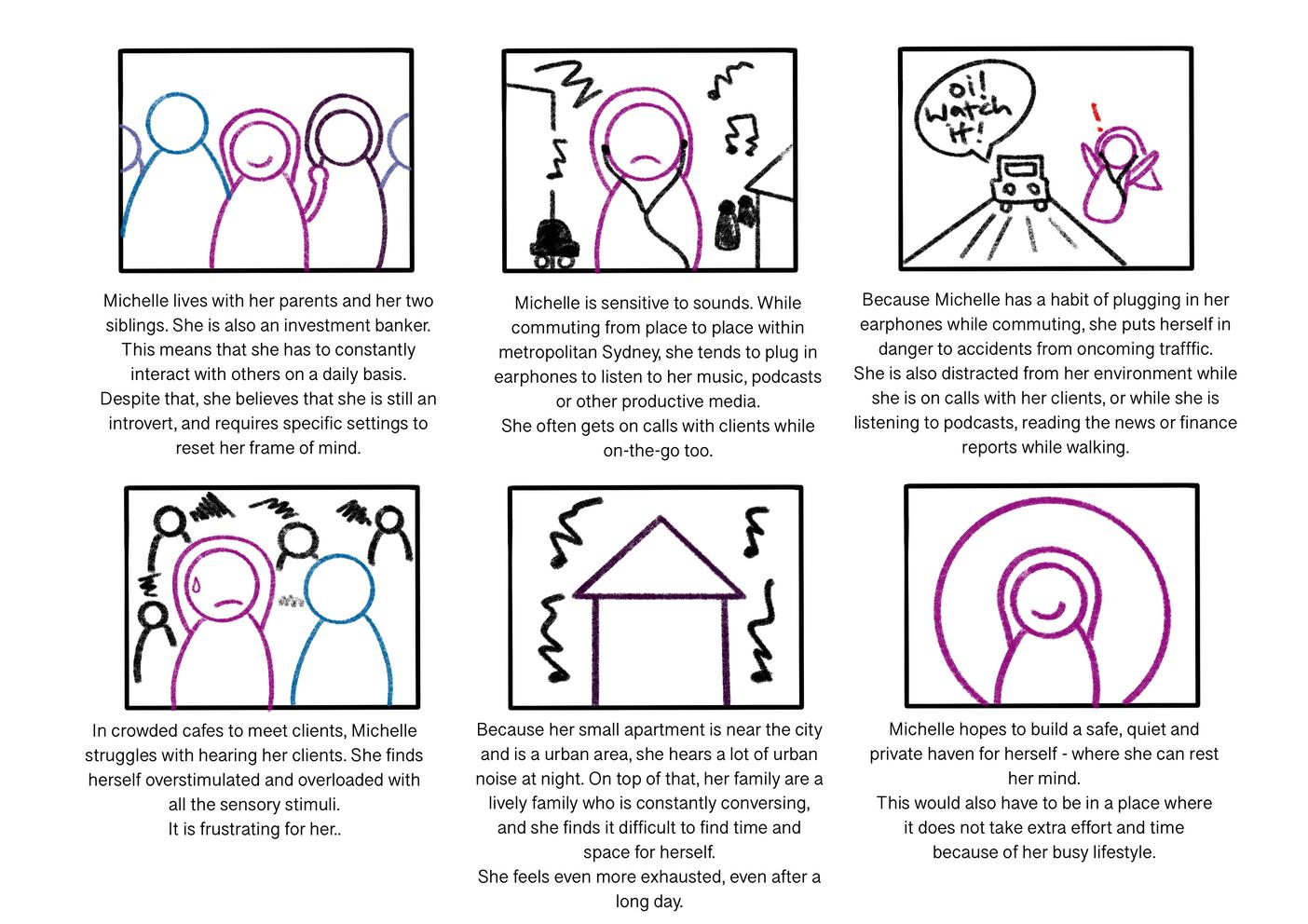



After understanding the problem and identifying key insights, these main points were put into use for ideation.
Firstly, the HMWs were revisited, and kept in sight during the entire process. Next, keywords were put into a mindmap to see the connection of ideas, and forced association was used as a method for further ideation.
Casual feedback from peers were received and taken. To arrive at the final solution, more secondary research was done, focusing on the feasibility of the idea based on current and uprising technology. (see Appendix 5)


(see Appendix 6)
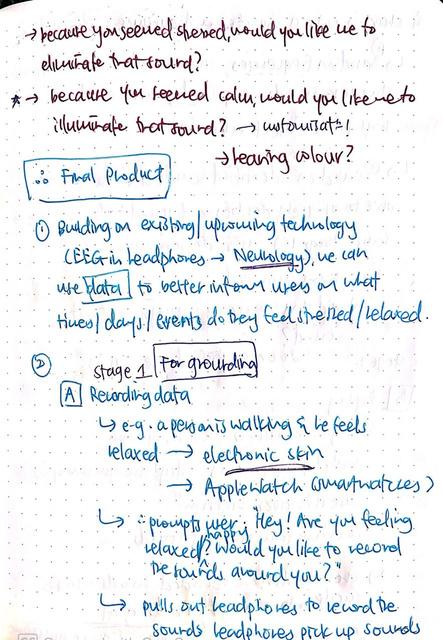
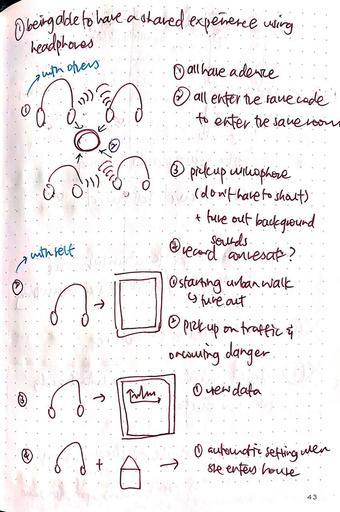
The final solution was decided through several iterations.

After getting feedback and doing secondary research, the more feasible, and that caters to most of the HMWs, solution was chosen.
The idea was to focus on building off the current technology of headphones.
Yet instead of purely adopting practices of future technology, reflecting on technological history was also helpful in ideating how we can use our past to create the future.
The first step consisted of putting into words the details of the ideas generated. This was key in flashing out the specifics of what was important about its interactions with the user, and whether these specifics answer to parts of HMWs. It also brought into light what priorities should be put forth first in the final product.
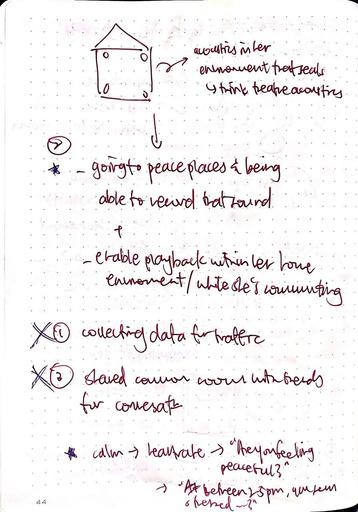
(see Appendix 6)
Iteration 1 consisted of two main parts: 1) eliminating the parts of the product that answers least to HMWs and personas, and are the least feasible, 2) choosing the part of the product that is of highest priority, and finally 3) charting and sketching the most important feature of the product into a user system flow diagram. The second version is then derived here.
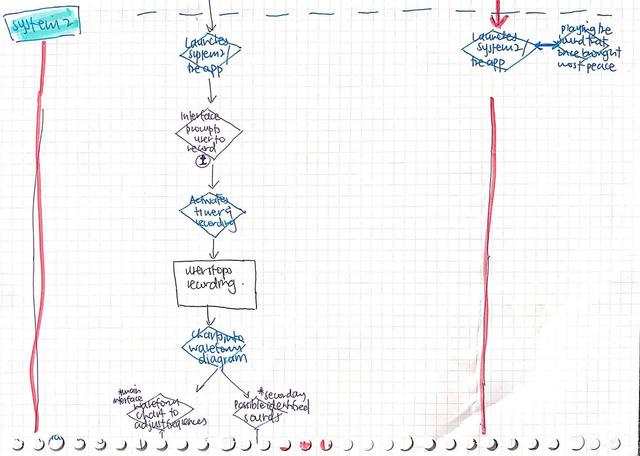
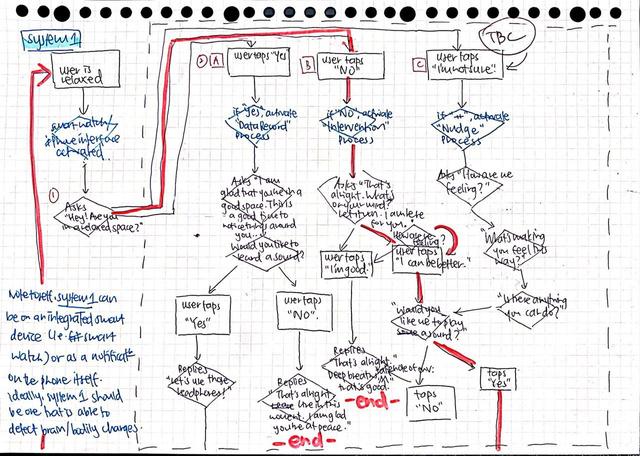
The decided element of the product circled around creating a grounding opportunity for the user - using sound - during times of stress, and to record acoustic details of their experience when they are relaxed.
The purpose is to encourage the user to enter a state of mind where they are able to reflect on their own actions, and to challenge them to reframe the woes in their mind.

prototypes (see Appendix 6)
1) the user-system flow diagram was digitised to better visualise the interactions of the user with the system(s),

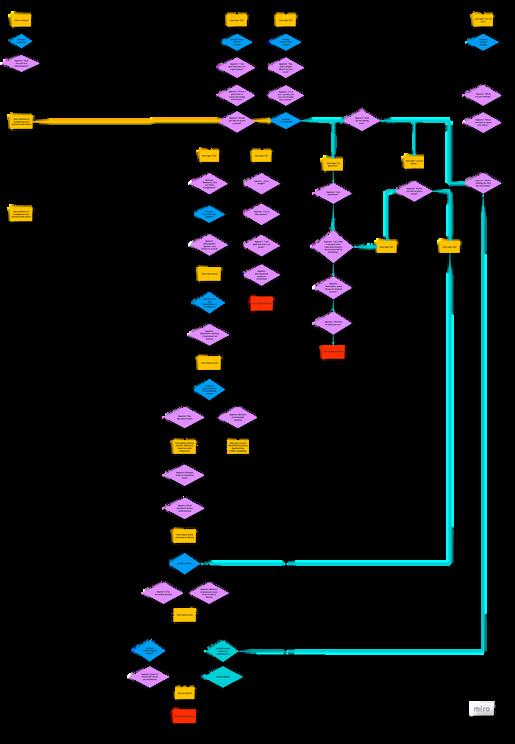
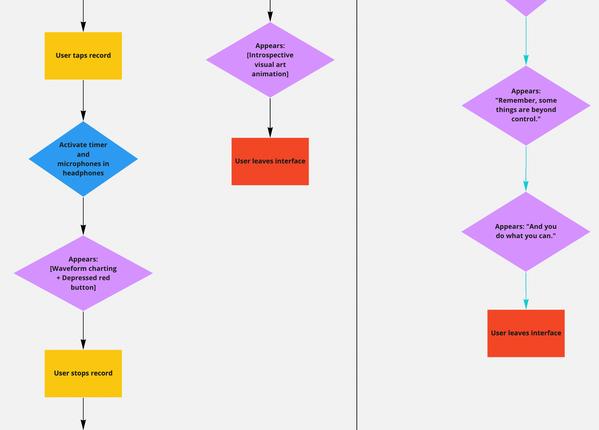
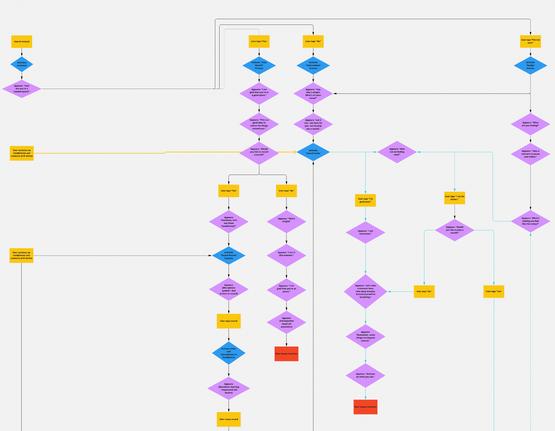
2) showcase the cause and effect (colour coded and shape coded) of these interactions with the product, and
3) the interface of the product that the user will see.
In general, the third version was a refinement of the users' interactions, and ensuring that there are ends to the user-system interaction (i.e. "User leaves interface"). Other details were also added, and connections were drawn to close loops.


prototypes (see Appendix 6)
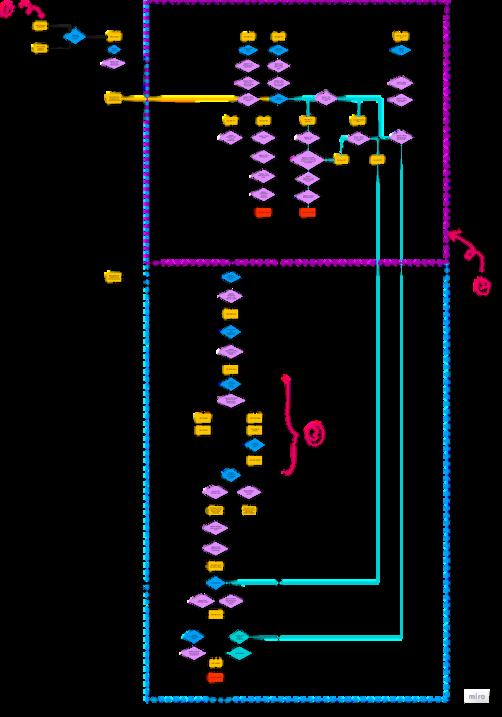

For Iteration 3, the main focus was on putting in caveats for user interactions. There were many assumptions made during the ideation and creation of the user-system flow diagram. Hence, new systems and interactions were also put in place to potentially cover for some of these assumptions. Usability heuristics were highly emphasised. Integration of other digital and smart devices was also used.
Version 4 looked into the importance of usability heuristics that impact user decisions. For example, are there points that allow user to make error, or go back to a previous interaction (interface)? The integration of other smart systems are also included, building off from current technology in the industry.
Integrationofothersmartsystemsthat helpactivatethemainproductsystem
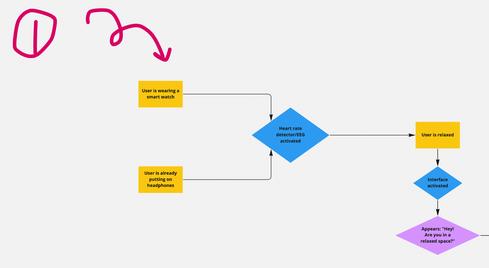

Errorpreventionmethodsandallowing redosforuserstofeelconfident









From Version 5, with greater clarify of what the interface would look like and what the interactions and system would include, key wireframes were done up to give a clearer picture of what the final prototype will be. The key wireframes were decided based on frequency of that interface appearing throughout the app and the points where user has important inputs to the system.


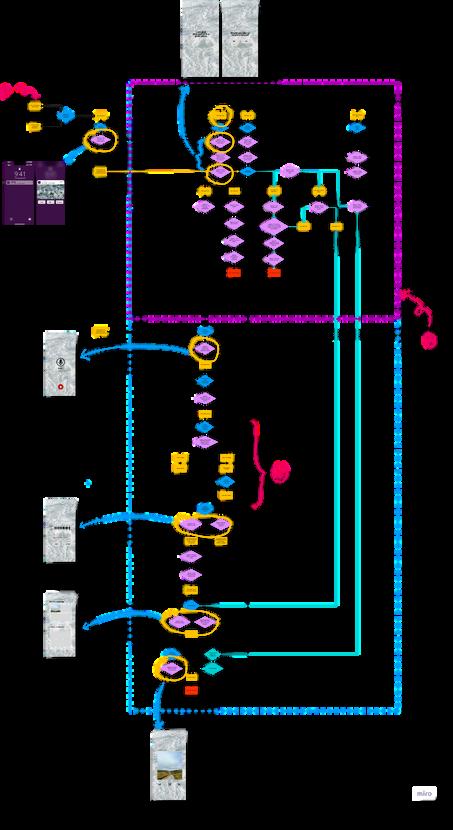


 A take on the researcher's and designer's bias. reflections
A take on the researcher's and designer's bias. reflections
Throughout the process of this report, there were several points of reflection.
1.

Interviews: I was concerned about the accuracy of my note taking, or whether or not I was translating words that the interviewee is giving me correctly. Definitely, there were solutions put in place to assist that (e.g. recording the interview), but even so, there is still this woe about recording everything.
2.

Contextual observations: Privacy, is the big word. I felt weird having to record people. Yet I question, am I really to walk up to someone and/or people asking for permission to take photos of them? Wouldn't that make the interactions with their headphones and phones unnatural and therefore defeats the purpose of a contextual observation? Also, how do I ask permission for passing groups of people?
3.
Questionnaires: I agree that questionnaires help get a bunch of quantitative data, but I think what I could have done better was to ask for demographics and emails for me to reach out. I felt that there were a few respondents I could have reached out to for a more elaborate explanation of their thoughts and feelings.
As a researcher, I am aware that I have my own bias in every stage of analysis - taking notes from interviews, clustering the data, choosing what to observe... My own bias (lens) would naturally lead to conclusions based on one person's (i.e. my own) perceptions. A tutor told me the whole idea of "aggregating", and emphasised the importance of triangulation. More importantly, an open mind... and to sit down, be humble.
There were points when I started to question whether or not the solution did solve the bigger and/or rooted problem (the dip in the design phase). I consistently referred back to HMWs, but there is certainly still doubt in what I was trying to achieve with the idea. I think this is when the importance of testings come in to observe how it fairs, and that only time can really tell the impact of the product, service or project. And a good reminder that design is not linear, and to trust the process!
There were also some reflections that are more specific to this project.
1. 2. 3. 4. a. 5.


Collecting the user's data (e.g. how and when they are relaxed), who then owns this data? In the same vein, when they record sounds, I assume they own this data. But if we were to have AI create music out of it for them to listen to, would they still own it? Or the company that produces the software to create "machine learning music"? Or the app developer themselves?
From the range of ideas during ideation to the final prototype, there could have been a better matrix used to evaluate which ideas are best for the final solution.
For the final prototype, a lot of the interactions were relying on users' input, and I think that's the danger of getting the app to gain traction. Unless it is already something very attractive to the user, or that the user is passionate about, I find it personally difficult to get someone to use an app that is about introspection (e.g. mental health related apps). Therefore, the question is, what would make it more interesting for a user to explore (e.g. including the AI created music section)?
More observations be made with how people use their smart devices as an integrated system. It was a little hard to know when one system (e.g. Apple Watch) interacts with another (e.g. headphones), and what sort of processes they will kick off in each other.
This also links to the question then of, "How do we accurately point out when the user is 'relaxed' for the entire interaction (i.e user system flow diagram) to start?
More research can be done into the impact of wearables for users what psychological effect does having control over your own devices have on a person's wellbeing,? Does is it even have impact at all?



68% of the world population projected to live in urban areas by 2050, says UN | UN DESA | United Nations Department of Economic and Social Affairs. (2018). Un.org. https://www.un.org/development/desa/en/news/population/2018-revision-of-world-urbanization-prospects.html
A Brief History of Headphones. (2020, October 6). LSTN Sound Co. https://lstnsound.com/blogs/main/a brief history of headphones
Harvard. (2018, May). Dopamine, Smartphones & You: A battle for your time Science in the News. Science in the News. https://sitn.hms.harvard.edu/flash/2018/dopamine-smartphones-battle-time/
AIVA The AI composing emotional soundtrack music. (2016). Aiva.ai. https://www.aiva.ai/

Alt Shift X. (2013). The Doppler Effect: what does motion do to waves? [YouTube Video]. In YouTube. https://www.youtube.com/watch? v=h4OnBYrbCjY&ab channel=AltShiftX
Apple Support. (2021). How to use Sound Recognition on your iPhone or iPad Apple Support [YouTube Video]. In YouTube. https://www.youtube.com/watch?v=Db9Xsw5Aa5w&ab channel=AppleSupport
Carruthers, T. (2017, November 29). Health effects of environmental noise pollution. Curious; Nova. https://www.science.org.au/curious/earth environment/health-effects-environmental-noise-pollution
Chow, A. R. (2020, February 5). “There’s a Wide Open Horizon of Possibility.” Musicians Are Using AI to Create Otherwise Impossible New Songs. Time; Time. https://time.com/5774723/ai music/ Contextual Observation. (2016). Designthinkmakebreakrepeat.com. http://designthinkmakebreakrepeat.com/methods/contextual-observation/ Cristol, H. (2019, June 19). What Is Dopamine? WebMD; WebMD. https://www.webmd.com/mental health/what is dopamine

Engineering for Engagement: Generation Z is the Earbud Generation. (2018). SXM Media.
https://www.sxmmedia.com/insights/events engineering for engagement generation z is the earbud generation
Hoffower, H. (2021, November 15). Forget AirPods Gen Z is making corded headphones cool again. Business Insider; Insider. https://www.businessinsider.com/gen z fashion trends reviving wired headphones airpods finance bro 2021 11
How the city affects mental health. (2022). Centre for Urban Design and Mental Health. https://www.urbandesignmentalhealth.com/how the city-affects-mental-health.html#:~:text=Cities%20are%20associated%20with%20higher,click%20here%20for%20more%20detail
McGilchrist, S. (2011, January 9). Music “releases mood enhancing chemical in the brain.” BBC News; BBC News. https://www.bbc.com/news/health 12135590 mischa. (2015, April 27). Fighting for breath. Curious; Nova. https://www.science.org.au/curious/earth-environment/local-air-pollution Music and the Brain. (2018). Harvard.edu. https://neuro.hms.harvard.edu/centers and initiatives/harvard mahoney neuroscience institute/about hmni/archive brain 1
Overload and the City. (2016). Centre for Urban Design and Mental Health. https://www.urbandesignmentalhealth.com/blog/overload and the city
reframing method | Reframing Studio. (2022). Reframingstudio.com. https://reframingstudio.com/reframing method#:~:text=Reframing%20is%20a%20design%20thinking,and%20identify%20future%20business%20opportunities. Stimulus Overload in the City | Applied Social Psychology (ASP). (2012). Psu.edu. https://sites.psu.edu/aspsy/2019/04/01/stimulus-overload-inthe city/
Studio Freight. (2021). Neurable. Neurable. https://neurable.com/ Triangulation: Get Better Research Results by Using Multiple UX Methods. (2021). Nielsen Norman Group. https://www.nngroup.com/articles/triangulation better research results using multiple ux methods/ Using “How Might We” Questions to Ideate on the Right Problems. (2021). Nielsen Norman Group. https://www.nngroup.com/articles/how might we questions/ Waters, J. (2021, August 22). Constant craving: how digital media turned us all into dopamine addicts. The Guardian; The Guardian. https://www.theguardian.com/global/2021/aug/22/how digital media turned us all into dopamine addicts and what we can do to break the cycle
Netflix, The Verge. (2015). The Future of Headphones.

Report Template and Icons by Canva.





Male, 56
Grew up in a suburban environment (but in a close community neighbourhood)
In a stressful/anxious situation, what do you do and/or where do you go to feel at peace?
I would go home and sleep. If the situation happens at home, I would go on walks. If I walked, I would likely go to a park.
In what areas/where do you feel at peace?
If I were to go to a park, I would like to find a place that is facing a river, or a pond, or maybe a beach.
What about your home makes you feel at peace?
Quiet, somewhere familiar
What about your park that makes you feel at peace?
Windy, lonely, quiet, can see passing birds, no one to disturb my time.
Facing a river or a pond because no people will be in my sight.
Based on your senses, what about these areas make you feel peaceful?
Home: where you feel comfortable i believe that whatever happens in the external world, i’m happy to come back home (to seek refuge)
Park: (As a joke) Smells of barbecue maybe?
What do you understand about the term “noise”?
Music can be noise anything that makes me feel uncomfortable and that I do not have a liking to. For example, a classical guy may not like rock music. Basically anything that doesn’t fit my mood can be noise.
Reflecting on your day-to-day, what sort of noise do you tend to hear?
Construction, hammering, mechanical noise
How about noise that is not part of your job?
Uncle quarreling in the toilet, that can be noise to me too.
How does the noise make you feel?
Work: distracting, agitated, frustrated because it disrupts my momentum and train of thought
What characteristics of the noise make you feel annoyed? (in priority)
1.
Loud
Unexpected
Female, 54
Grew up in a suburban environment (but in a close community neighbourhood)
In a stressful/anxious situation, what do you do and/or where do you go to feel at peace?
I will go home and sleep. I will also listen to music, or eat something that is comfortable to me like ice cream or chocolate.
What sort of music?
Like yoga, meditation music.
IIf the stressful situation is at home?
I will either go to my room to sleep or get out of the house.
I will usually go shopping, or go somewhere to get a cup of coffee, and do nothing.
I usually shop without an intention in mind, but if I see something nice I will get it.
But usually in those moods, I won’t want to buy anything, so I’m more likely to have a cup of coffee and something sweet like pastry.
In what areas/where do you feel at peace?
When I’m doing my own thing, I feel at peace doing my own knitting, watching TV, talking to friends
I think physically, home is my peace place. Sometimes, I go to the library.
What about this place makes you feel at peace?
Quiet, and I don’t know anybody, so there’s no expectation for me to entertain anybody.
Based on your senses, what about these areas make you feel peaceful?
Smells are important.
I don’t like libraries with mold because they’re old. They are never messy, books are always arranged nicely, like my house.
What do you understand about the term “noise”? Anything that doesn’t suit my mood, that is noise.
Reflecting on your day-to-day, what sort of noise do you tend to hear?
People talking when you shop around, when you are having a cup of coffee people never stop talking.
I don’t mind nice music when I go to a place though, it’s relaxing.
Like how when they play Christmas music during the festive season, it makes me feel good.
Bus horning (public transport) but I think it’s quite normal. Car passing by, bus horning, they are just for a few seconds, but
I cannot stand industrial machine noises the drilling, the banging…it’s consistent, and it’s very annoying. I can’t stand that.
Agitated. I cannot focus on my work. Sometimes I will try to make use of music to recalibrate my mood, but sometimes my music is never loud enough to beat the environment noise so it becomes noise on noise…
What characteristics of the noise make you feel annoyed?
I think it’s based on moods. I think it works the same for people as well. E.g. if you talk to certain people, you’ll feel nice. But if you talk to some people, it makes you feel bad. I think noise is also situational.
The street I lived on ended in a cul de sac (not too many people will go there)
Nowhere in the city where you can get a completely silent space
In a stressful/anxious situation, what do you do and/or where do you go to feel at peace?
When I’m stressed, my first instinct is I don’t like being inside because I feel suffocated so I’ll take a walk and get some fresh air.
I think physical activity is very good for me walking is good.
And I like walking in places where it is quiet and not too many people around.
But if I don’t have the capabilities to walk outside because it is at night or bad weather or whatever, I will use my laptop or look at social media, just to get my mind off the stress.
You mentioned social media and walks, but do you think these help truly resolve the stress and make you feel at peace.
I think it makes me feel at peace for 15 mins or so but I know that they are not mechanisms to solve the issues. These mechanisms are just temporary. But I feel there is no point in me doing work when I'm stressed it’s like my mind is jumbled, and I can’t think straight.
In what areas/where do you feel at peace?
My bedroom would be my first protocol there is something peaceful about coming back home after a long day at work like, it’s peaceful and calming.
Bodies of water are also very peaceful. I really like the sounds of water and walking along the water.
But where I live is not very close to a park so there isn’t a water body too close to me. So I would probably go to the nearby park at a quiet corner and probably observe people, but not in a creepy sort of way. And I think there is some peace in being able to savour what is going around you.
What about the places you mentioned make you feel at peace?
Silence in the bedroom, and also having control of my own space, and having my own choice of music. I get to control sound, music, the lighting etc. I think that control gives me peace.
Being in nature helps me be away from the city. But actually even being next to a fountain can be peaceful too. Just watching and listening to the water flowing, hypnotised by water going back and forth.
I also really like watching the sunset and seeing colours that are not on your screen. It gives me the feeling of being grateful.
Based on your senses, what about these areas make you feel peaceful? (Imagine)
Smell of water, smell of nature (soil), smells of freshly cut grass I think it’s those smells that we have to go out of our way to uncover that makes them rare and also peaceful.
Certain areas should be reserved for certain needs > don’t study on the bed Park is sometimes like that > smells of park are like that > triggers me into a certain state of mind
What do you understand about the term “noise”?
I think it has negative connotations. I would think of noise as distraction sounds, it’s like I am trying to process something at the moment, and there’s this thing that disrupts my train of thought.
I think there’s a difference between sound and noise though. Sound is something that can be present even when I am trying to concentrate, but noise takes my attention away from that.
Reflecting on your day to day, what sort of noise do you tend to hear? (Imagine)
[Sound of] Cars is big one.
People chattering and people’s conversations.
In a cafe would be plates clattering, steaming of the milk for coffee…
People typing while I’m in class…
Like, even at where we’re seated now, people’s footsteps are also noisy.
I feel like so much of our noise now, people typically ignore it because they are so used to it too.
page)
Oh, also traffic lights because I walk to uni, and occasionally people shouting on the streets when they say hi to each other, and run to each other and give one another hugs.
What characteristics of the noise make you feel annoyed?
It disrupts my thinking, getting in the way of what I’m trying to do.
I think other people’s sounds can also be really annoying, especially when they are blocking out the conversations that you are having, or even just an internal conversation with yourself.
Loud sounds, for sure.
Repetitive sounds, like an alarm’s beeping noise.
*Obnoxious sounds (she uses this word a lot), like when I’m having conversations with a friend, but other people come and speak really loudly next to us.
I really dislike these boisterous people, like they are just not considerate to others.
But now that I think about it, I think because I live in the city, I get used to a lot of the urban sounds.
How does the noise make you feel?
Depends on whether it’s negative or positive.
I think in some situations, I think noise is quite useful. For example in coffee shops, the jazz music or the steaming of the milk sounds really help me with my productivity.
Working in complete silence can feel too formal.
I think for me I could do half a day in a coffee shop where there’s a bit of background sounds and hustle and bustle, and half a day at home where it’s a lot quieter. Like, a little bit of noise is fine.
How do you counter the feeling that noise makes you feel?
Headphones for sure…
Removing myself from the situation…
And I think the nature of work that I’m doing helps me decide if I should move. If I need to focus really hard, then I think I would move to a quieter location. But if it’s just some no brain work, then a cafe with some people and music would be a good environment.
What sort of stuff do you listen to using your headphones?
Music with no words would be very good because I tend to get distracted.
And also if I choose music with words, I tend to have to think of the sort of sounds and words that I want to hear after the first song. So I will get distracted trying to think of the songs I want to play next.
I tend to choose ambient jazz music for studying as well.
Male, 24
Grew up in a urban environment but quieter neighbourhood
In a stressful/anxious situation, what do you do and/or where do you go to feel at peace?
To the park. I used to stay near Central Park, so I would go there to look at dogs.
What about dogs make you feel at peace?
Just them being carefree and running around
Besides the park, is there anywhere else you would go to feel at peace?
The beach? I think I would listen to the sound of the ocean and the waves. I would just chill and observe and listen and just watch the world go by.
What would you observe?
Observe people and birds, looking at their interactions, nothing too specific. I would look at the sun and the ocean and just… chill.
What about this place makes you feel at peace?
Outdoors, relatively quiet, some elements of nature, not much technology. You wouldn’t think about work or stressful situations when you are at those places.
Do you think these places being “peaceful”, do you think it’s biological, or are they only peaceful because they are IN CONTRAST to what we experience day to day?
I believe it’s both actually. I think part of us knows that such places are rare, and I also believe we are all cavemen at the end of the day.
Now let’s switch it up. What are some places that do NOT make you feel at peace, and stressed? I want to be specific and say that places that do NOT bring you peace and are stressful are different. Think of stressful places as a level 2 level, and unpeaceful as level 1.
Not at peace, I think of a crowded place and it can be anywhere.
I imagine people brushing past, getting squished, being lost in the crowd.
I imagine feeling hot and humid, feel sweaty people brushing past my arm, smelling whatever is there, like a night market (straight association to night markets), people chattering too.
Stressful, Exam hall.
I think there would be total silence, I would be constantly look at the clock, And the environment would be feeling anxious and stressed (charged).
What do you understand about the term “noise”?
I think noise doesn’t have to be noisy. There can be white noise, brown noise etc
I imagine construction noises. There doesn’t have to be music and other sounds present to have noise.
You have given me examples of noise, but how would you define noise? Anything can be noise, but not silence.
Reflecting on your day to day, what sort of noise do you tend to hear? (Imagine) Ambulances, and Loud motorcycles and cars.
These sounds are loudest throughout my day, which is why I remember them because they leave the biggest impact on me.
I’ll feel uneasy because it would feel like they are screaming in my ear. It scares me too because they can be unexpected, and comes out of nowhere.
I wouldn’t want to be near any of these.
How do you counter the feeling that noise makes you feel?
Honestly, there’s nothing that I can do. If an ambulance comes by, I’ll just stand there and let it pass. I mean, I can’t control it.
But if it’s consistent loud sounds, I will move somewhere else. But if it’s just for that 30 seconds, I won’t do anything.
What characteristics of the noise make you feel annoyed?
I think it’s just loud and unexpected sounds. But I do alright with loud and unexpected sounds I would do things that does not require too much brain work, like reading and writing some stuff.
But if I require heavy analysis or thought processing, I would move out of the situation.
Note:someofthesepointsweretranslated,buttheywererecitedbacktothebilingualparticipanttoensureaccuracy
Inastressful/anxioussituation,whatdoyoudoand/orwheredoyougotofeelat peace?
Iwoulddotwomainthings:
1.Talktomyclosefriendsorparents,andmaybeaskforsuggestionstomitigatesome problems
Iguessthismaynotworkforotherpeople,butIknowItendtotalktopeopletoreduce myemotions[levelsofupset].
2.Pluginearphones
Andthengosomewhererandomtowalk.MostofthetimethatIdon’thaveadestination inmind,Ijustwalk.Like,Ijustwanttowastehalfanhouroftimejusttodosomething relaxing.
WhenIwouldwalkinBeijing,Iwouldgotothepark,orsomewherewithchildren somewherewithhappyemotions.ButhereinSydney,Itendtogotouniandwalkaround theareaacoupleoftimes.Iguessit’sbecauseIamfamiliarwithuni,andIdon’twantto gosomewhereunfamiliaratnight,especially.
AndIthinkwhenIfeelnervous,Idon’twanttogosomewherebusy.Somewherequiet helps
Besidestheparkorsomewherefamiliar,arethereanywhereelseyouwouldgofora walk?
Itdoesn’thavetobeapark,Ithinkitcanbeanywherethatmakesmefeelcomfortable.
Youwerementioningearphonesbeforeaswell,whatdoyouusuallylistentowhenyou goonthesewalks?
Imaychoosewarmsongs,itencouragesmetostaycalm.
ButIthinkmostofthetimeIwilllistentosomethingupbeattoperkmyselfup.
Whatisawarmsong?
Oh!Iguessthey’rejustgentlesongs.
IseeIsee.Speakingofparks,whataboutthisplacemakesyoufeelatpeace?
WhenI’mnervous,I'llgotoanatureplace.Ienjoynaturalplacestofeelatpeace.
I think it’s not just about nature too. I think if I was stressed, I would go somewhere wIth the people around you [with activities that] make the place happy.
For example, I would go to the park because families go there for picnics There is a certain happy ambience, and I would go there to soak in the atmosphere.
Based on your senses, what about these areas make you feel peaceful? (Imagine)
I don’t think it’s something that I can describe with words it’s more so a feeling.
What do you understand about the term “noise”?
Sounds that make you feel uncomfortable e.g. someone playing badly on the piano. I think noise is not just construction, but also [sounds that come up when] the timing is not good, or generally sounds bad.
Reflecting on your day to day, what sort of noise do you tend to hear? (Imagine)
In Beijing, where I lived, it was near a school.
So every year there are new students coming in, and there are also construction noises for new students that move in.
At night, there were also parents and children that will have arguments before bed over assignments.
For me, sleep is important, and hearing these arguments at night doesn’t help.
In Sydney,
I think the only time I remember hearing any sort of noise is when someone, at 2am, was playing the piano - but he played well, so I don’t think that really irritated me.
How about general urban noises?
Buses and all that don’t affect me. I kinda got used to them, growing up in the city. I feel like the buses and all that are normal to me.
How about construction noises? Have you ever experienced it being part of your life? Maybe not.
How does noise make you feel?
Angry, first.
In Beijing, if I hear parents argue I’ll be like “wtf?!”. and then I’ll think “that is so NOT necessary.”
In general, for noise, if it’s short, it’s fine.
But If it’s a long time, I’ll get super irritated. (next page)
OH! I just remembered, the worst [time I experienced noise] when i was studying for the biggest nation wide exam in high school in Beijing, when I was trying to focus, there was a party happening downstairs in my community, and I was surrounded by these party noises
I had to complain to someone in the community, and then they came in to stop the party. The party was not necessary.
I think ultimately, it depends on context so for example the exam was important to me, therefore I was irritated.
But I’ll just be angry at first, and the unexpectedness makes me irritated.
How do you counter the feeling that noise makes you feel?
I would wear headphones, or move away. Or in the worst case, I would change my house, like adding double glazed windows or something.
If it’s not a strong sound or not for a long time, I would put in earphones.
But actually, in general, it’s quite quiet in my community, so I do not need to plug in. Like car noises, I got used to it.
You mentioned listening to music, what sort of music do you listen to? Blues, jazz, I listen to everything really.
Female,20
Grewupinaurbanenvironmentbutquieterneighbourhood Hadtomoveoutofhometowntoanothercityforschool
Note:someofthesepointsweretranslated,buttheywererecitedbacktothebilingualparticipanttoensureaccuracy
Inastressful/anxioussituation,whatdoyoudoand/orwheredoyougotofeelat peace?
Iwouldgototheparktoseedogsplayingaround Orwalktothebeachandlieonthebeach. Ialsolistentomusic.
OhIalsodosports,likeIplaysquash.IplaysquashonMondaysinuni it’spartofaclass andthere’sacoachthere.Sheteachesus.
Andalsogoinghiking.
/Pause/ MaybeI'lltalktofriends.
MybestfriendstaysinCanadasoit’shardtocommunicate soIendedupspammingtext.
Iobservethatsomeoftheseareactivitiesseemtobeforawayofdistraction,how aboutforpeace?
Ithinkperhapstheparkandthebeach
Whataboutthisplacemakesyoufeelatpeace?
Forthebeach,ithelpsmegetawayfromthecity kindaquieterthantheotherplaces. Parksbecausewell,dogsarecute.
Whenyousaygettingawayfromthecity,whatinthecitydoyouthinkyouwanttoget awayfrom?
Thereisalotofnoiseinthecity,soIthinkit’sjustgettingawayfromthat. Iamanintrovertedperson,soIwanttobeleftalonealotofthetime.
Ihaveajobnearthebeach,soit’sjusteasytogetthere Ijusthavetowalkdown.( >it’s easilyaccessible).Butit’sonlywhenIfeelreallystressed,Iwillheaddowntothebeach andtakealongpause.
I would prefer something with stronger beats and bass, just to make me feel happy. ( > upbeat)
Based on your senses, what about these areas make you feel peaceful? (Imagine) Because I hear nature sounds, like birds chirping.
I haven't hiked here much, but when I was hiking in China, it feels fresh when you hike up.
I think, when it is noisy in the city, I would want to go hiking.
Actually, when I am super stressed, I will be super sensitive to sound. Like even at home, when my mum walks past me, I will feel uneasy.
How would you describe fresh? Smells of trees is what I feel when i hike
What do you understand about the term “noise”?
I think it’s largely based on the volume. And if there are a lot of things happening at the same time a lot of sounds coming together. Something that is sharper in sound as well.
Like noise is also when, even after sitting there for a while, it is still really loud.
From what you’ve spoken of before, it seems like you are giving me examples of noise… but what about a definition?
Perhaps something that makes me feel irritated. And also I think if it is something I can control, I won't feel too bad, but if it’s something that is not within my control, I will find it irritating.
If it is a noise that is not within your control?
I would listen to headphones, or I would move away. I would listen to whatever that I feel like that day no specifics. And I think if the city is noisy, I will move out of the city vice versa.
appendix 1 Reflecting on your day to day, what sort of noise do you tend to hear? (Imagine) People talking, construction sounds, doors shutting. (next page)
I can’t seem to control it I know it is their right to talk, but for me, it is annoying. It is the same as door shutting, it’s not within my control, and also construction.
How does the noise make you feel?
I get freaked out by these sounds.
For example, when I’m in a very quiet situation, and a loud noise scares me, I’ll get irritated.
Maybe I’ll feel angry too.
Listening to what you’ve told me so far, you seem to have a very inward way of dealing with noise. There were past interviewees whom I spoke to, who would vent out this frustration by sharing it with someone else. Say, they will complain to their mum about the couple who’s fighting upstairs and they will kinda share this feeling of frustration together. Do you think you would do that?
No. I think even if I spoke to someone, there’s nothing that can be done. So there’s not really a point in vocalising it.
You mentioned you were an introvert, would you approach someone who is making too much noise and irritating you?
I think if it’s once or twice, it’s fine. But if it’s consistently, I will ask the person to shut up.
Male, 21
In a stressful/anxious situation, what do you do and/or where do you go to feel at peace?
What do I do, When I’m stressed, I pace around the room, and itch and get hot, and I get a bit out of breath, and I get too loud around people sometimes.
I tend to tune out stressful situations and observe people. When I see that other people are not stressing out, I will not stress out.
What I would also do, I will just walk around an area, preferably quiet, and meet other people. I will talk to people to try to think about something else and distract myself from the situation.
You have mentioned activities you would do, how about places you would go?
It’s either the park or like the shopping mall it’s either or.
The park because it’s nice or calm, and it gives me the space to be alone with my thoughts to think of what to do next.
If it’s the shopping mall, I will get a drink, sit around, listening to people. Take a break to listen to how people live their lives eo that i can feel at peace. Look at other people’s lives and not evaluate my own.
What about this place makes you feel at peace?
I would say the park is vast, there is a lot of space for me to pace up and down, take a walk.
It can be crowded too, so that I will listen in to people’s conversations.
It’s cooling sometimes too, I can sit down on the bench.
It is also active, I can take a break and see the world revolve and move.
Shopping mall it’s kinda the same.
Crowded, big, activity going on. It’s fast paced, it calms me a bit, it’s like taking a break from my life.
Based on your senses, what about these areas make you feel peaceful? (Imagine)
Park would be the sounds of the leaves, or kids running around playing games in the park, or like birds chirping, and like the wind blowing against the leaves and trees And I think, the subtle smell of the flowers sometimes.
Sometimes I would sit on the grass, and it could feel soft, I guess
And for the shopping mall, it’s more of the smells as well probably food, coffee shops, coffee, tea and having the smells of food there
I don’t really use touch for the shopping mall, it’s usually sight, smell and taste.
What do you understand about the term “noise”?
Noise is basically made by a person, it can be perceived by someone as good or bad. Noise can also be medium volume where multiple people can hear. So whether it’s a good or bad sound, it just depends on the person.
Reflecting on your day-to-day, what sort of noise do you tend to hear? (Imagine)
When I wake up, it will be the white noise from the aircon and air purifier, then the ringing of the alarm clock.
When I get up, when I open the windows, I would hear cars driving back and maybe the guard house person talking or people on the sidewalk talking to each other. Occasional dogs barking and birds chirping from below the street.
Later on, if it’s raining, I will hear the pitter patter on the window.
When I go out to shop, I mostly hear people talking, people having conversations on the phone, people talking on their phones, murmuring of people on public transport. The sounds of people’s footsteps on the pavement like they’re rushing, I hear that too.
After that, again more music played in the shopping centre. Then after shopping, I would go out and run, and I would hear people doing their own business in the background when I go out to run. I hear people jogging, running, leaves ruffling, water flowing by the reservoir. I will hear the sounds of my own breath. I listen to music when I run too, so also that.
And then I get home, I eat dinner, I will hear the loud voices of family members. Very lively sounds everywhere. Then at night, I would hear the fan of the computer in my room.
Then I’ll just go to bed. I think those are the sounds I would hear on a typical day.
page)
All that you’ve mentioned are sounds in general. But out of all these, which of these do you think are noises?
The fan from the computer, and the noise from my aircon and purifier.
I call them noise because they don’t make me feel anything, if it’s there, it’s there. But I am not bothered by it, I’ll just let it be.
I guess noises are something that you hear everyday, but it doesn’t bother you, then that’s noise.
How about sounds that make you feel irritated? Negative emotions?
For me, I don’t think there are any sounds that make me feel irritated. Rather, I think it’s silence that makes me feel uncomfortable. Like when there is no sound, when no one is saying anything, I feel like nothing is happening, and I feel like I’ll anticipate something bad is going to happen.
And when it’s quiet, I feel like I’m not moving, and I'm just stationery while everything else is happening.
Sometimes when it’s quiet, I just watch videos just as background noise.
I feel like having no sounds present makes me feel like the world is going on, and I am not moving with it.
How does the noise make you feel?
Lack of noise makes me feel anxious. It will also feel lonely. When there are no sounds, I will feel like I’m very alone.
I will just feel stuck. And in a stressful situation, I will have to play something to make me feel like I’m moving, and that I’m not stuck.
For me, it’s mostly just loneliness and anxiety.
How do you counter the feeling that noise makes you feel? Because you mentioned watching videos and playing some music from before. But besides that, is there anything else that could help you?
I would call someone.
I would go out and take a walk. I would listen to people talk, and when you really listen, you’ll understand that people have problems too, and it’s quite reassuring, and I would feel better about myself.
I think honestly, just being surrounded by sounds, but not like blasting noises
I would listen to slow music because there is a flow to it. I wouldn’t play blasting music though, I would only play it in the gym.
People talking, it’s sounds made by someone like someone playing a loud song, with people singing in it. Like there are times when I want to listen to it and sometimes I don’t.
Like I would play these blasting noises to drown out my emotions, but if I want to think, or do an assignment, I wouldn’t play this sort of music.
Something with a heavy bass, like pop. And rock, heavy metal. It’s basically those songs with people singing people with voices singing. I think that's probably it.
I see. So what sort of music would you choose to play?
I would even play songs that are in games like Genshin Impact because it’s calming. It’s soft and mellow. And I don’t have to pay attention to it. With the songs with lyrics, I will have to pay attention to the lyrics because people tend to tell their stories through their music. With background music, I don’t have to process that. Especially when I am getting some work done, or when I have to think, I don’t want to have to process someone’s story.
Oh! I forgot to mention, background music also makes me feel emotions. Like when people sing lyrics, they have my attention, so I will give my attention. But with background music, then I will give it my emotions instead.
Grew up in a urban environment with majority elderly Female, 22
In a stressful/anxious situation, what do you do and/or where do you go to feel at peace?
Currently I would go to the beach, the sounds of waves are very significant to me.
Before that, I would just “inner peace” it out at home.
I would probably watch videos or read something interesting just to get my mind off the anxious or stressful situation.
It seems like you only mentioned the beach as the only place that brings you peace, so what are the properties of this special place that makes you feel at peace?
It’s just the vibes, and the ocean is big, and it helps you reframe my state of mind to see the problems you face as small.
What about this place makes you feel at peace?
I think it feels constant, and it feels stronger than you are. It is everlasting, like what are your issues? The ocean is one of those things which has survived for years, houses so many things, and one of the most powerful forces on Earth.
It also makes me feel like what I'm looking at is a problem that is a lot smaller than it is.
Based on your senses, what about these areas make you feel peaceful? (Imagine)
I think for the beach, it’s always about the sound, and if you stand close enough, you'll feel the splashes it’s refreshing!
I think also like, when you go near a pond and don’t smell fish, it’ll smell like salt and it feels peaceful.
And quiet, I guess.
So far, this is the first time you used the word “quiet”, do you think quietness helps restore your sense of peace then?
Yes and no.
I think if it’s quiet, I don’t have to feel like I am distracted by the bigger problems.
But I think if it’s too quiet, I will have that feeling of loneliness, like there’s too much happening in my head. Especially when I’m living by myself now, I think quietness will make me feel lonely.
In that case, does quietness make you feel at peace?
I think more specifically white noise helps.
Right, let’s circle back to “quiet” how would you define it then?
I think it’s complete silence.
What do you understand about the term “noise”?
Kids screaming in the middle of the airport, and things like, when you go near clubs, or the lecture halls and everyone is talking, or when everyone is having individual conversations at the same time.
I see, what you’ve mentioned to me so far seems to be examples of noise, but how do you define it?
Constantly loud. Shrills.
Like fire alarms, and repeating, And screechy and sharp sounds.
How does the noise make you feel?
Annoyed, I guess. I am not very sensitive to sounds, so it feels okay to me.
Reflecting on your day to day, what sort of noise do you tend to hear? (Imagine)
Traffic sounds, honking, especially when I’m driving.
Community sounds people talking while walking.
Maybe some crazy person who modified their engine and it’s really loud when they drive past. I’ll just be like… “Uhm okay…”.
Do these sounds annoy you? No.



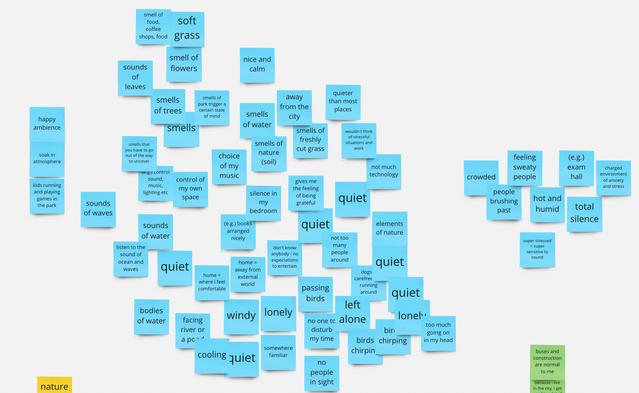
link here: https://miro.com/app/board/uXjVPbhW8sc=/?moveToWidget=3458764532107668007&cot=14
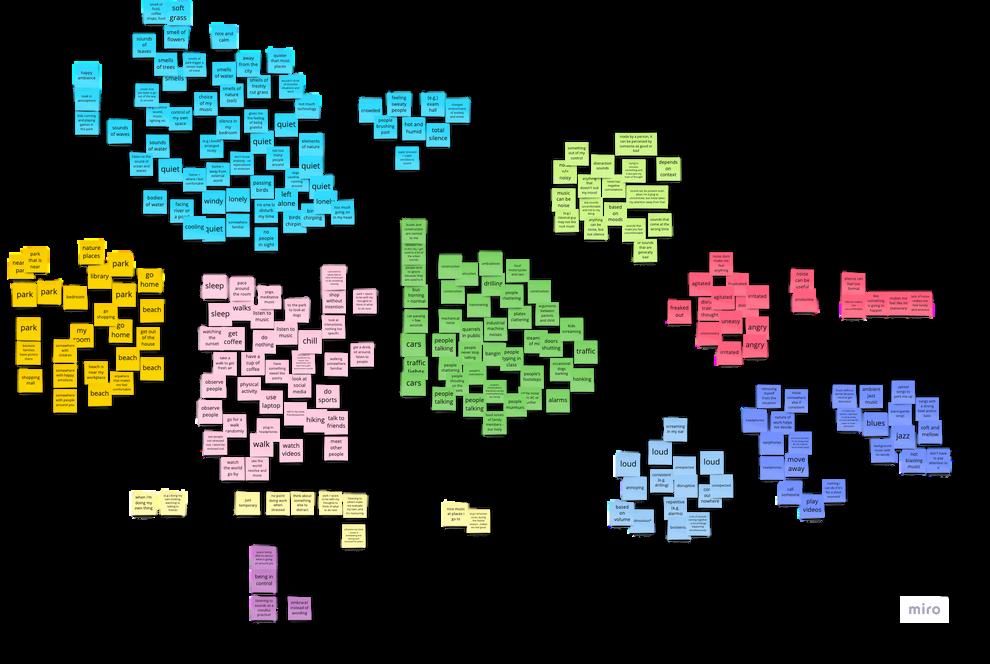
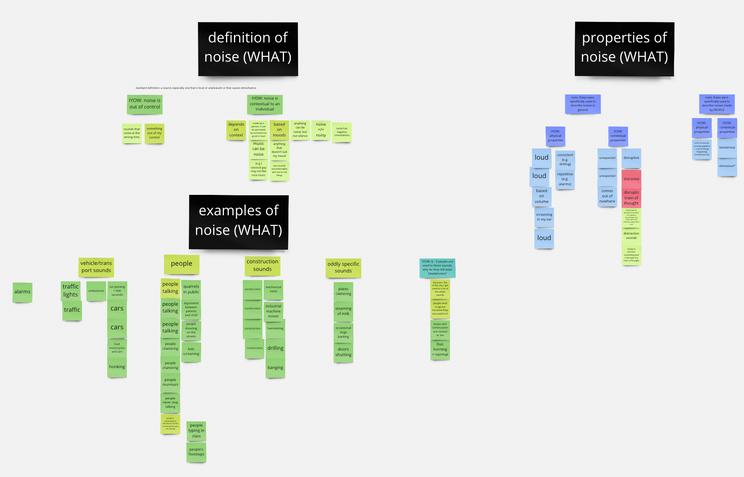
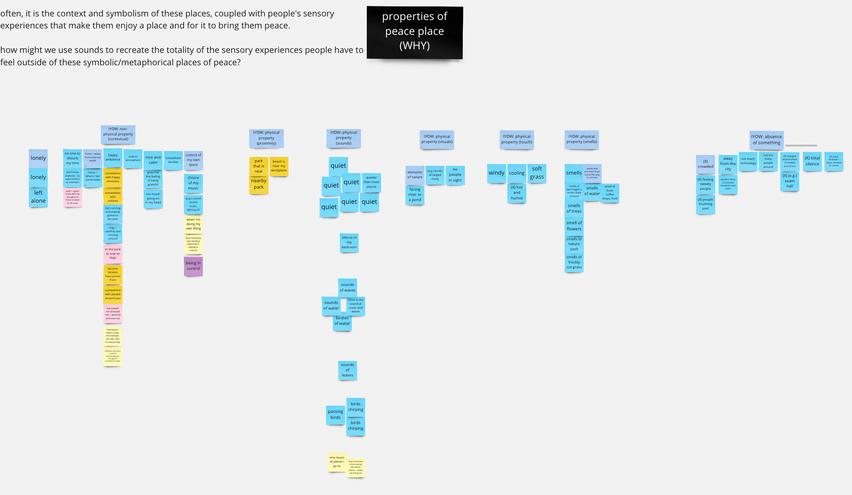
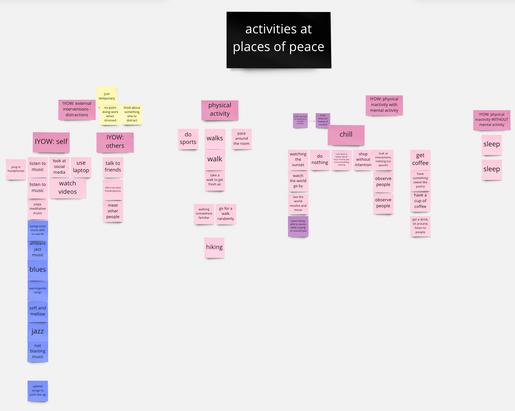
link here: https://miro.com/app/board/uXjVPbhW8sc=/?moveToWidget=3458764532107668199&cot=14
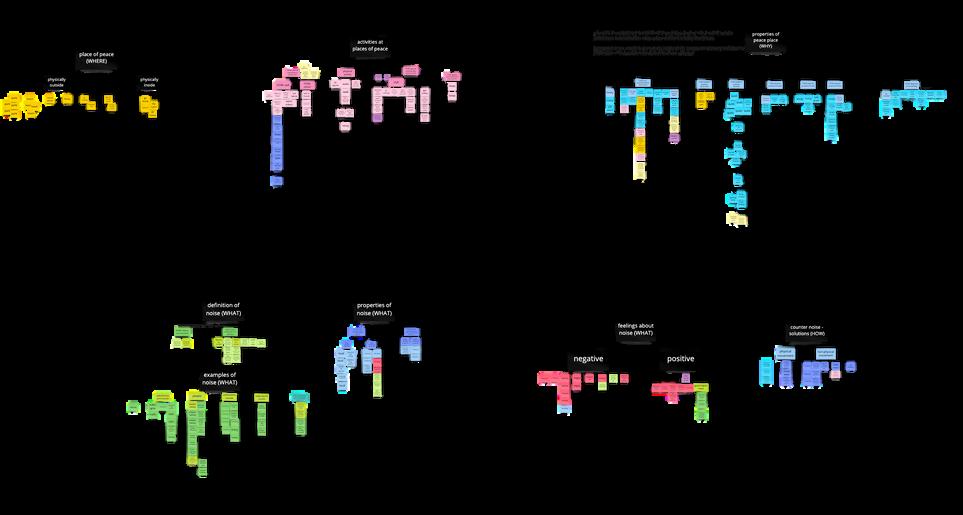

26 responses
Publish analytics
How quiet do you think your living neighbourhood is?
26 responses
How quiet do you think your workplace is (e.g. office, university etc)?
26 responses
Out of 24 hours in a typical day, how much time do you listen to selected sounds in TOTAL (e.g. music, podcasts, videos, TikToks etc)?
26 responses
Lessthan1hour 1-2hours 3-5hours 6-12hours Morethan12hours
How often do you choose to listen to your own selected sounds rather than the environmental sounds at the place you are in (e.g. listening to music/podcast on the train or at work instead of surrounding noise)?
26 responses
How often do you choose to listen to your own selected sounds (e.g. music, podcasts, videos etc) rather than the environmental sounds at the place you are in, while commuting in a city?
26 responses
How often do you choose to listen to your own selected sounds (e.g. music, podcasts, videos etc) rather than the environmental sounds at the place you are in, while in nature?
26 responses
How often do you choose to listen to your own selected sounds (e.g. music, white noise, nature sounds etc) to restore your state of peace in a stressful situation?
26 responses
To what extent does music impact your mental wellbeing?
responses
To what extent does environmental sounds in the place you are in (e.g. silence, traffic sounds, birds chirping) impact your mental wellbeing?
responses
What sounds make you feel at peace? Rank them from 1 to
Silence Forestsounds(e.g.birdschirping… Watersounds(e.g.runningriver,…
If you have put 'Others not mentioned' as the 1st, 2nd, 3rd, 4th or 5th Choices, please provide examples.
Or if you have Other sounds that make you feel at peace, explain them too!
If not, put NA.
26 responses
NA
People talking in a public setting
Radio to get to know new songs/ reconnect with old ones
Library/Cafe noise
background noise like a podcast or a show at low levels
I don’t mind resting to the sound of other people living, taking and doing things. E.g a coffee shop has nice background sounds but the CBD sounds busy and isn’t calming at all
Car noise, but not too loud
N A
Na
This content is neither created nor endorsed by Google. Report Abuse - Terms of Service - Privacy Policy

For protection of privacy, faces have been covered up.
However photo and video evidence were kept only for personal viewing, to help observe the interactions between users and their headphones (and phones), as well as how common these instances are.

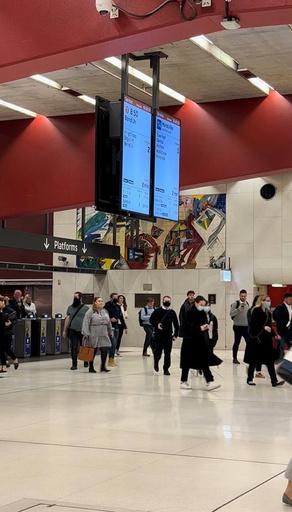


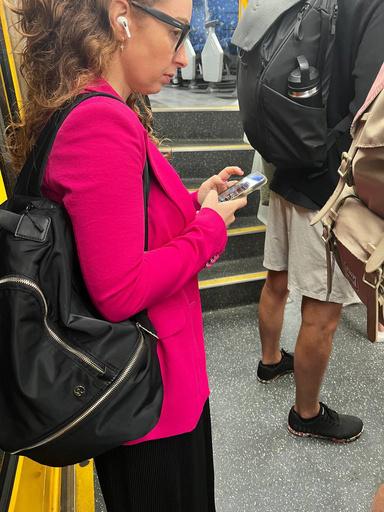


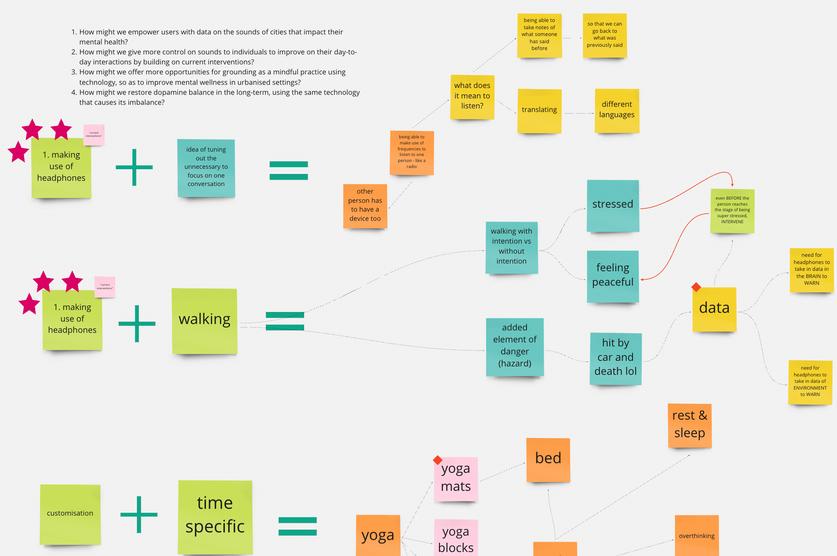
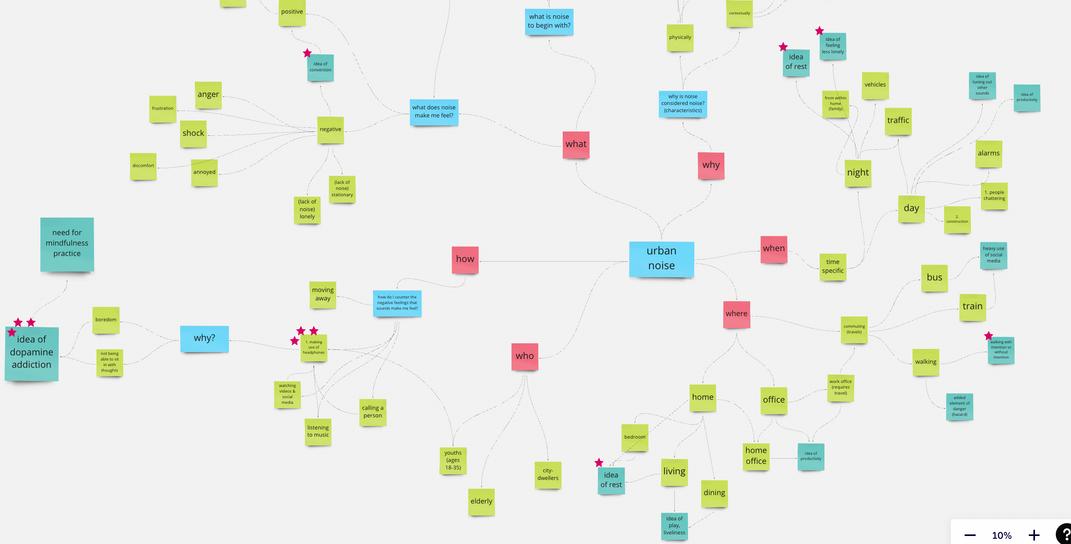
link here: https://miro.com/app/board/uXjVPbhW8sc=/?moveToWidget=3458764532361056469&cot=14


link here: https://miro.com/app/board/uXjVPbhW8sc=/?moveToWidget=3458764532524167078&cot=14

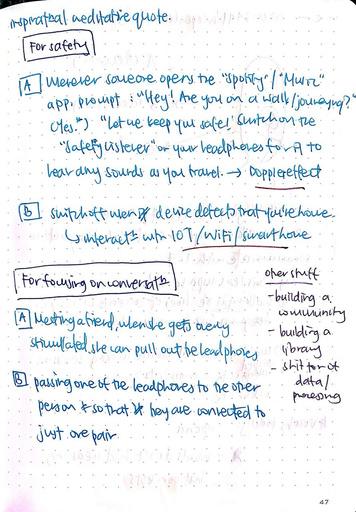
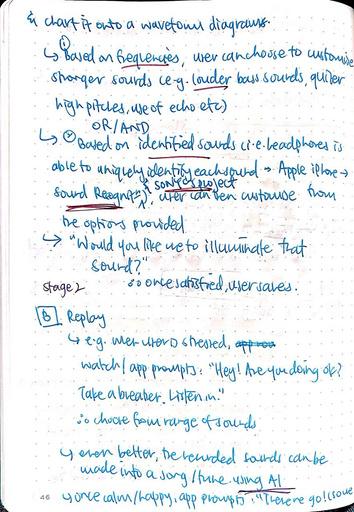


link here: https://miro.com/app/board/uXjVPbhW8sc=/?moveToWidget=3458764532524167078&cot=14


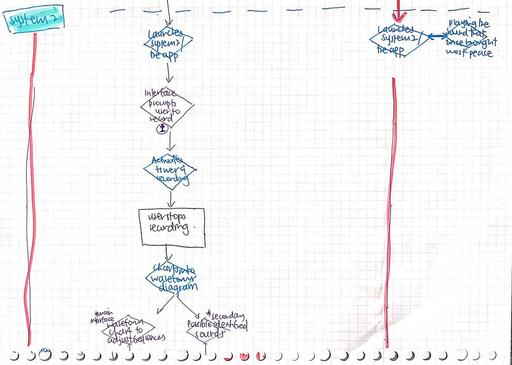
link here: https://miro.com/app/board/uXjVPbhW8sc=/?moveToWidget=3458764532524167078&cot=14

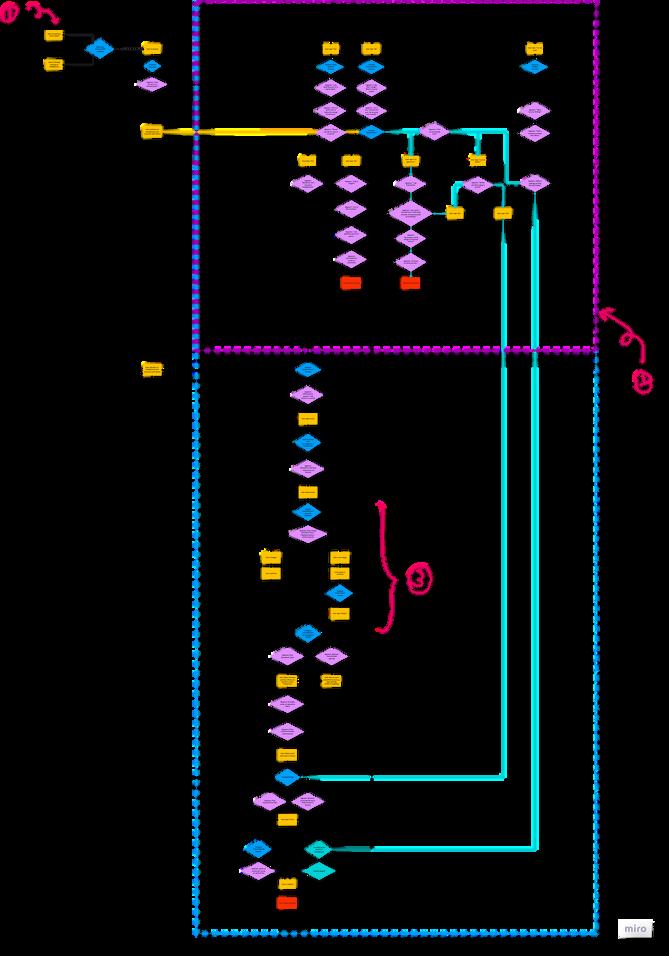
link here: https://miro.com/app/board/uXjVPbhW8sc=/?moveToWidget=3458764532524167078&cot=14

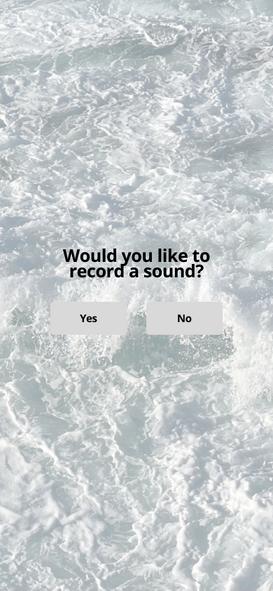

link here: https://www.figma.com/file/Fo68rRCwthWF3LICZPvC2e/Soundscape-Wireframes-(DECO2200-A1)?node-id=0%3A1

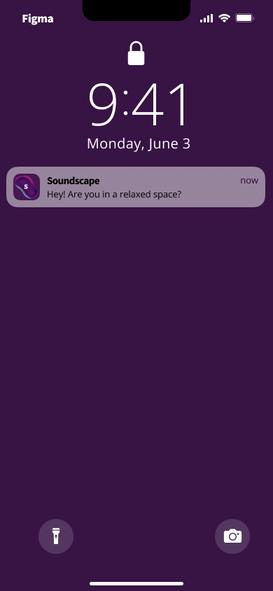



link here: https://www.figma.com/file/Fo68rRCwthWF3LICZPvC2e/Soundscape-Wireframes-(DECO2200-A1)?node-id=0%3A1


I would like to thank my friends, family, course mates, tutor (Brittany Klaassens), unit coordinator (Dr. Senuri Wijenayake) and others who have provided guidance to my journey thus far.